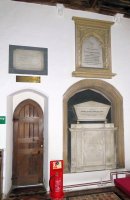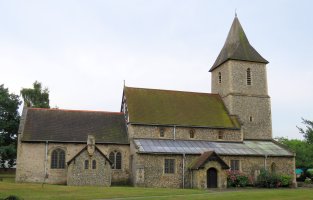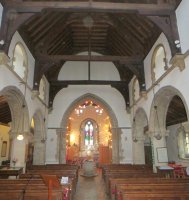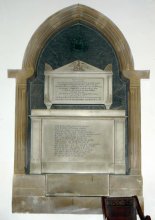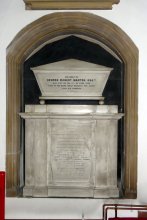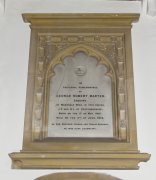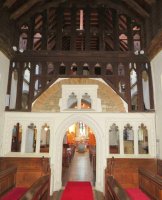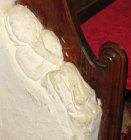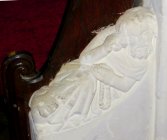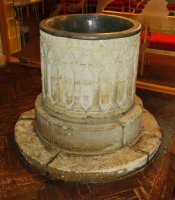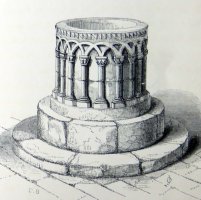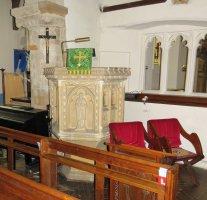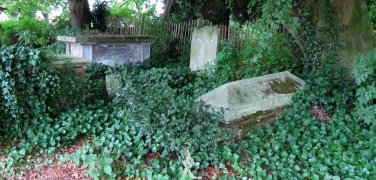St Leonard's Church, Sandridge - Monuments
The secular visitor to Sandridge St Leonard’s is unlikely to come for the monumental panels, which are few, but instead for the Norman features, including font and arches, and an older Roman brick arch, incorporated into what is mostly a 14th Century plan.
Though the monuments are our focus on this website, a few comments on the building:
Sandridge Church, Herts.
The exterior, a flint-faced structure with tower and broach spire, and nicely pitched roofs to the nave and lower chancel, has an attractively varied outline, with projecting aisles to the nave, porches beyond that, but a complete look reflecting a thorough Victorian workover in 1886-7.
The Church was built in the late 11th or early 12th Century, just a nave and chancel at first, with use of some Roman tiles, which have been kept through various expansions and restorations and can be seen here and there in the walls. Later in the 12 Century aisles were added to the nave, then a tower. First to be replaced was the chancel, in about 1400, and then the tower collapsed in 1688, a replacement only being put up after a pause until 1837. It was done on the cheap, began to crack within a few years, was repaired, and then replaced later in Victoria’s reign in the 1886-7 refurbishment, which also redid the roofs and added the clerestory, added a North porch to augment the medieval south one, and extended the aisles flush with the new west tower – the architect being William White FSA (his surviving drawing of the interior layout dates from June 1887).
Sandridge Church, Herts.
Once inside, the Norman and other early features become more apparent, but first the monuments.
Monuments
The Church contains just half a dozen monuments, four of which commemorate members of the Marten family, and of these, two are large white-on-black pieces, each within its own large arch. We take them in date order.
Charles Nevinson, d.1809 (?), white panel with lightly carved line borders, and cut out corners, on a dark rectangular backing.
John Clarke, d.1820, his wife Elizabeth [Cotton] Clarke, d.1797, and an infant daughter, Susannah Clarke, d.1793, erected by a surviving daughter. White panel with upper shelf on a dark, streaky backing, supported on two scrolled brackets.
Jane [Nevison] Marten, d.1809, first wife of George Sulivan Marten noted below, and her three young children, Edward Richard Marten, d.1809, Charles Sullivan Marten, d.1809, and Edward Torin Marten, d.1810. Under an arch, panel is carved as a tomb-chest end, with upper pediment and acroteria (‘ears’), within which is a small carving of the Pelican feeding her young, a bit battered with the heads gone, but careful remaining carving to the wings. To the sides are carved upturned, smoking torches, symbolic of life snuffed out, and the whole is on a black backing panel with pale streaks, most effective, and with a shield of arms with a wreath carved above the main panel. A monument of size and with presence.
Jane and George Marten monuments, on a grand scale.
George Sulivan Marten, d.1826, and second wife Charlotte Marten, d.1862, daughter of Lieut. Col. Tucker, with a short eulogy and biblical quote. The inscribed panel has pairs of pillars to the sides, and a heavy top and base, seriously monumental. On top, a casket rests on ball-feet, recording their son, George Robert Marten, d.1876 – unusually, he has a second separate panel noted below. All within a great round-headed arch, with a black backing cut at the top. There is a little book about the area dating from the 1950s, which complains about this and the monument noted above, referring to ‘disfigurement of the chancel by white marble memorials’, which ‘originally were more offensive than now for they were situated in the sanctuary, one each side, and thrust their front towards the altar.’
George Robert Marten, d.1876. A characteristic Victorian Gothic memorial panel. The style is of a blind window, with the inscription on white marble where the windowpane would be, and the surround, by strong convention, in beige stone, normally a fine sandstone, rather than the marble prevalent in Classical panels. Such pieces are found on all scales, from very plain ones with a couple of side pilasters [flat pillars] and that is all, to moderately decorated ones, as here, to ornate pieces in the great cathedrals. Here we have a five-headed window, low relief carved shields on leaves in the spandrels – the triangular shapes to the upper sides of the arch – and then a fireplace-style surround with frame, with repeating Tudor-style flowers (remember, Tudor is a form of Gothic) upper and lower shelves: note the difference between the curves of a Gothic shelf from a Classical one. Above the inscription is a roundel with a low relief carving of a bird holding a wreath. Satisfying.
Gothic panel to G.R. Marten.
Lieutenant Thomas Smith, d.1918, killed in action in Mesopotamia. Gilt lettering on pale panel, with gilt line border, and a frame of grey stone with mouldings. Quite Arts and Crafts.
Also in the Church
Roman arch. A complete arch of brick, within which is a double window, set above a stone screen, and with a further wooden construction above, to form a complete screen rather than the normal Chancel arch, of mixed dates: the Roman arch, thought to be from some local Roman villa rather than any ecclesiastical building, may have been incorporated in some original Saxon church on the site, or into the 12th Century one; the stone windows and lower screen are from 1396-1401, or maybe reused from the 12th Century, and the wooden structure above is from the 1880s work.
Medieval sculpture from the Chancel arch.
Carved reclining figures, small and simple, one on each side of the door through the screen, so presumably also dating from the very end of the 14th Century: one is very battered, but the other is a recognisable medieval bearded figure holding a rope, in a pleasingly contorted pose.
The Norman font, noted and described in Paley’s standard work on fonts as ‘altogether a very good specimen of the latter part of the 12th Century’, cylindrical, with around it some 18 arches, crossed across each other in typical Norman fashion, but, unusually, flat rather than having some in front and some behind, and each resting on little pillars with capitals of dogtooth design.
The Norman font.
Three Norman arches along the nave on each side, supported by pillars with characteristic capitals on a larger scale: good things. The aisles were added in the later 12th Century, so this will be when those arches were erected.
Medieval tiles, with remains of circular designs on some, the better preserved ones around the altar, and others in front of one of the Marten monuments: these latter were gathered from around the Church, mostly under the pews, in the 1886 revamp and set together, and most recently conserved in 2014. 14th or 15th Century.
Eagle lectern, a rather good one from the 1880s refurb.
Stone pulpit, hexagonal and Gothic, also from the 1880s, incorporating a small statue of St Leonard - we can recognise him by the chain he holds, as he was patron saint of prisoners - a picture of this statue is at the top of the page (click to enlarge). Incidentally, both lectern and pulpit were the gifts of the Marten family, whose monuments were ungratefully sneered at in the 1950s book noted above.
Stained Glass windows, good late Victorian work, including one to the Revd. John Griffith, Vicar from 1872-1890 who thus oversaw the 1880s restoration of the Church, and a good WW1 piece, and a bold 1950s one to Alan Leonard Hunt, d.1955 on active duty in Kenya, which the casual observer might have taken for St George and the Dragon, were it not for the reference to Satan [hence St Michael] and that the armoured figure holds the Scales of Justice.
Roman Chancel arch.
Outside the Church
The Churchyard has been largely cleared, with some number of surviving headstones mostly away from the Church by and against the walls. A few more ornate ones, notably to Gertrude Uhlhop of New York, with carved flowers, much decayed, a red granite pillar to Charles Sharpe, d.1913 in Australia, and a brick chest tomb to the Thrale family, with stone panels to 18th Century members on the sides, and at the ends panels recording that the vault was erected by William Norman of Tokenhouse Yard, Citizen of London, and, even more unusually, that ‘The Opening of the Vault his [sic, lies?] 3 Foot 6 Inch from this End of the Tomb.
The entrance to the Churchyard is a 1921 lychgate serving as a WW1 memorial - you can see it if you click to see the full sized picture of the Church tower at the top of the page.
.
The Church website is at https://www.sandridgechurch.org.uk/welcome/about-us/history/.

